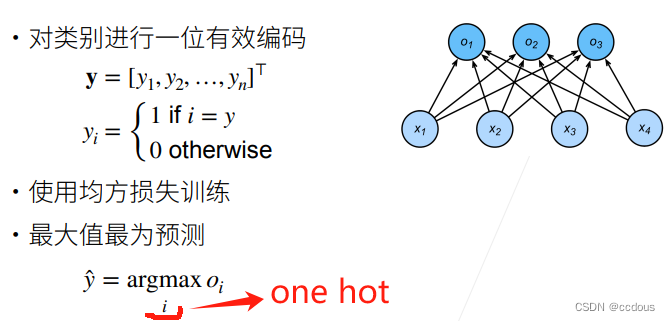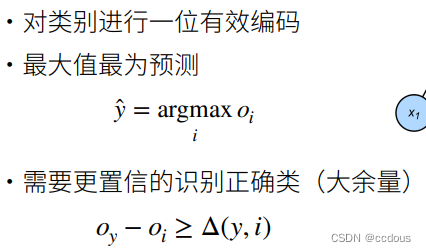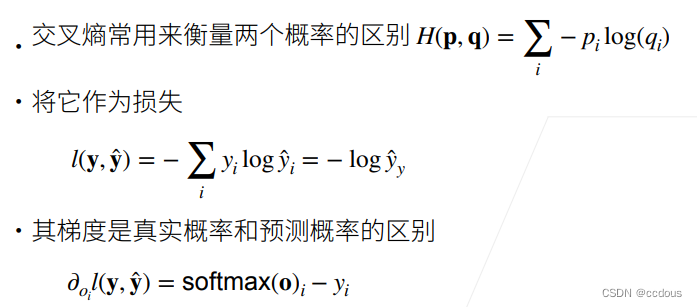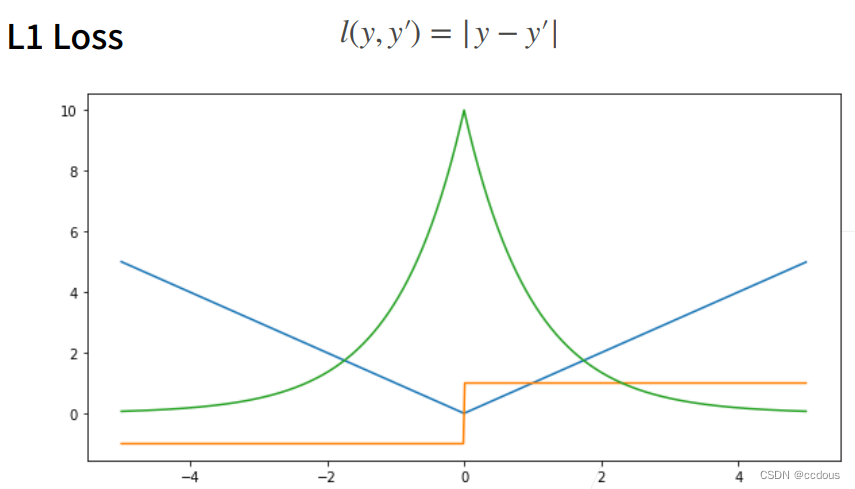一、概念
1、softmax回归其实是一个分类问题
2、回归估计一个连续值,单连续数值输出,跟真实值的区别作为损失。
3、多类分类
(1)分类预测一个离散类别,多个输出,输出为第i类的置信度
(2)均方损失

独热编码:将类别变量转换为二进制矩阵的编码方式,常用于机器学习和深度学习中处理分类数据。其基本思想是将每个类别表示为一个向量,其中只有一个位置的值为1,其余位置的值为0。
(3)无校验比例

使对正确类别的置信特别大,将正确类与非正确类大大拉开距离使其差距大于某一阈值
(4)校验比例

对向量处理使其成为概率(全为非负,总和为1)
4、交叉熵损失

5、总结

二、损失函数:衡量预测值和真实值之间的区别
1、蓝色:y=0时,变化预测值y’的函数;绿色:似然函数e^(-l()),是高斯分布;黄色:梯度函数
2、导数决定如何更新梯度
3、L2 Loss

损失函数的导函数是一条直线,说明损失函数越靠近原点变化越小,所以梯度更新就越慢
4、L1 Loss

5、Huber's Robust Loss:将L1与L2进行优化

三、图像分类数据集
MNIST数据集是图像分类中广泛使用的数据集之一,但作为基准数据集过于简单。 我们将使用类似但更复杂的Fashion-MNIST数据集 。
1、导包
%matplotlib inline import torch import torchvision from torch.utils import data from torchvision import transforms from d2l import torch as d2l
2、读取数据集
(1)数据集下载
# 通过ToTensor实例将图像数据从PIL类型变换成32位浮点数格式,
# 并除以255使得所有像素的数值均在0~1之间
trans = transforms.ToTensor()
mnist_train = torchvision.datasets.FashionMNIST(
#train=True表示训练数据集
root="../data", train=True, transform=trans, download=True)
mnist_test = torchvision.datasets.FashionMNIST(
#train=False表示测试数据集
root="../data", train=False, transform=trans, download=True)
(2)数字标签索引及其文本名称之间进行转换
def get_fashion_mnist_labels(labels): #@save
"""返回Fashion-MNIST数据集的文本标签"""
text_labels = ['t-shirt', 'trouser', 'pullover', 'dress', 'coat',
'sandal', 'shirt', 'sneaker', 'bag', 'ankle boot']
return [text_labels[int(i)] for i in labels]
(3)可视化样本函数:这个我不了解啊,老师就说同学们看看,呜呜呜呜
def show_images(imgs, num_rows, num_cols, titles=None, scale=1.5): #@save
"""绘制图像列表"""
figsize = (num_cols * scale, num_rows * scale)
_, axes = d2l.plt.subplots(num_rows, num_cols, figsize=figsize)
axes = axes.flatten()
for i, (ax, img) in enumerate(zip(axes, imgs)):
if torch.is_tensor(img):
# 图片张量
ax.imshow(img.numpy())
else:
# PIL图片
ax.imshow(img)
ax.axes.get_xaxis().set_visible(False)
ax.axes.get_yaxis().set_visible(False)
if titles:
ax.set_title(titles[i])
return axes
3、读取小批量
batch_size = 256
def get_dataloader_workers(): #@save
"""使用4个进程来读取数据"""
return 4
train_iter = data.DataLoader(mnist_train, batch_size, shuffle=True,
num_workers=get_dataloader_workers())
4、整合组件(就是总和)
#例子里的图片是(1,28,28),如果我们后面要用到大的图片,可以使用resize去更改大小
def load_data_fashion_mnist(batch_size, resize=None): #@save
"""下载Fashion-MNIST数据集,然后将其加载到内存中"""
trans = [transforms.ToTensor()]
if resize:
trans.insert(0, transforms.Resize(resize))
trans = transforms.Compose(trans)
mnist_train = torchvision.datasets.FashionMNIST(
root="../data", train=True, transform=trans, download=True)
mnist_test = torchvision.datasets.FashionMNIST(
root="../data", train=False, transform=trans, download=True)
return (data.DataLoader(mnist_train, batch_size, shuffle=True,
num_workers=get_dataloader_workers()),
data.DataLoader(mnist_test, batch_size, shuffle=False,
num_workers=get_dataloader_workers()))
四、softmax回归的从零开始实现
1、导包
import torch from IPython import display from d2l import torch as d2l batch_size = 256 train_iter, test_iter = d2l.load_data_fashion_mnist(batch_size)
2、初始化模型参数
num_inputs = 784 num_outputs = 10 W = torch.normal(0, 0.01, size=(num_inputs, num_outputs), requires_grad=True) b = torch.zeros(num_outputs, requires_grad=True)
3、定义softmax操作
def softmax(X):
#对于任何随机输入,我们将每个元素变成一个非负数
X_exp = torch.exp(X)
partition = X_exp.sum(1, keepdim=True)
return X_exp / partition # 这里应用了广播机制
4、定义模型
def net(X):
#这里W.shape[0]=784,X是256*28*28,X.reshape((-1, W.shape[0]))令X成为256*784的矩阵
#X*W+b的值
return softmax(torch.matmul(X.reshape((-1, W.shape[0])), W) + b)
5、定义损失函数
#y是真实标号,y_hat是按类别分来的预测概率
def cross_entropy(y_hat, y):
#y_hat[]指取出其中指定位置元素的列表,放一个例子在下面
#y_hat[range(len(y_hat)), y]取出了真实标号的预测概率
#-logy为计算交叉熵损失
return -torch.log(y_hat[range(len(y_hat)), y])
cross_entropy(y_hat, y)

6、分类精度
def accuracy(y_hat, y): #@save
"""计算预测正确的数量"""
if len(y_hat.shape) > 1 and y_hat.shape[1] > 1:
#我们取出预测的每一类别的最大估计值的下标
y_hat = y_hat.argmax(axis=1)
#将估计下标与真实下标做比较拿到一个关于预测值的bool类型的tensor
cmp = y_hat.type(y.dtype) == y
#将cmptensor转化为数值类型求和
return float(cmp.type(y.dtype).sum())
#取平均,得到精度率
accuracy(y_hat,y)/len(y)
(2)任意数据迭代器data_iter可访问的数据集, 我们可以评估在任意模型net的精度
def evaluate_accuracy(net, data_iter): #@save
"""计算在指定数据集上模型的精度"""
if isinstance(net, torch.nn.Module):
net.eval() # 将模型设置为评估模式
metric = Accumulator(2) # 正确预测数、预测总数
with torch.no_grad():
for X, y in data_iter:
#accuracy(net(X), y 评估值与真实值预测精度
metric.add(accuracy(net(X), y), y.numel())
#分类正确的样本数和总样本数的比例
return metric[0] / metric[1]
实用程序类Accumulator,用于对多个变量进行累加
class Accumulator: #@save
"""在n个变量上累加"""
def __init__(self, n):
self.data = [0.0] * n
def add(self, *args):
self.data = [a + float(b) for a, b in zip(self.data, args)]
def reset(self):
self.data = [0.0] * len(self.data)
def __getitem__(self, idx):
return self.data[idx]
7、训练
(1)训练模型一个迭代周期
def train_epoch_ch3(net, train_iter, loss, updater): #@save
"""训练模型一个迭代周期(定义见第3章)"""
# 将模型设置为训练模式
if isinstance(net, torch.nn.Module):
net.train()
# 训练损失总和、训练准确度总和、样本数
metric = Accumulator(3)
for X, y in train_iter:
# 计算梯度并更新参数
y_hat = net(X)
l = loss(y_hat, y)
if isinstance(updater, torch.optim.Optimizer):
# 使用PyTorch内置的优化器和损失函数
updater.zero_grad()
l.mean().backward()
updater.step()
else:
# 使用定制的优化器和损失函数
l.sum().backward()
updater(X.shape[0])
metric.add(float(l.sum()), accuracy(y_hat, y), y.numel())
# 返回训练损失和训练精度
return metric[0] / metric[2], metric[1] / metric[2]
(2)训练函数
def train_ch3(net, train_iter, test_iter, loss, num_epochs, updater): #@save
"""训练模型(定义见第3章)"""
#可视化
animator = Animator(xlabel='epoch', xlim=[1, num_epochs], ylim=[0.3, 0.9],
legend=['train loss', 'train acc', 'test acc'])
#num_epochs轮循环
for epoch in range(num_epochs):
#训练模型、更新、拿回训练损失和训练精度
train_metrics = train_epoch_ch3(net, train_iter, loss, updater)
#在测试数据集上测试精度
test_acc = evaluate_accuracy(net, test_iter)
animator.add(epoch + 1, train_metrics + (test_acc,))
train_loss, train_acc = train_metrics
assert train_loss < 0.5, train_loss
assert train_acc <= 1 and train_acc > 0.7, train_acc
assert test_acc <= 1 and test_acc > 0.7, test_acc
(3)小批量随机梯度下降来优化模型的损失函数,设置学习率为0.1
lr = 0.1
def updater(batch_size):
return d2l.sgd([W, b], lr, batch_size)
(4)使用
num_epochs = 10 d2l.train_ch3(net, train_iter, test_iter, loss, num_epochs, trainer)
五、简洁实现
1、导包
import torch from torch import nn from d2l import torch as d2l batch_size = 256 train_iter, test_iter = d2l.load_data_fashion_mnist(batch_size)
2、初始化模型参数
# PyTorch不会隐式地调整输入的形状。因此,
# 我们在线性层前定义了展平层(flatten),来调整网络输入的形状
#第0维度保留,其余维度全部平展为向量,变成2维
net = nn.Sequential(nn.Flatten(), nn.Linear(784, 10))
def init_weights(m):
if type(m) == nn.Linear:
#初始化权重
nn.init.normal_(m.weight, std=0.01)
net.apply(init_weights);
3、损失函数
loss = nn.CrossEntropyLoss(reduction='none')
4、优化算法(学习率为0.1的小批量随机梯度下降作为优化算法)
trainer = torch.optim.SGD(net.parameters(), lr=0.1)
5、训练
num_epochs = 10 d2l.train_ch3(net, train_iter, test_iter, loss, num_epochs, trainer)






















 1742
1742

 被折叠的 条评论
为什么被折叠?
被折叠的 条评论
为什么被折叠?








